The route leads to Sicily after this corner of Italy, which we detail below to get an idea of our route of travel to this destination.

Photography by loriszecchinato
Routes to consider:
Trapani:
Sicily has three main airports: the Palermo in the north, Catania in the east and finally the smallest and most modest of the three in the west, the Trapani. RyanAir is based on the latter, and that’s where we can fly (and back). Trapani is a quiet coastal town settled in one of the few plains of the island, and is bounded on the south by an extensive area of Salinaro belonging to the town of Marsala.
Segesta:
If I were forced to choose only one from the impressive Greek temples that are scattered in Sicily, would have a difficult decision between Segesta and Selinunte. And that the Valley of the Temples in Agrigento is by far the most famous of all, and yet not impact your visit and get to move as much as these two.
In Segesta all the elements conspire to bring the wonder and delight, a giant Doric temple, virtually intact. Eternally unfinished work, he never was covered with a roof and therefore could not be consecrated. Engineering marvel of the V century BC, completely surrounded by nature and no human impact on the landscape, which is the most surprising. If you are moved to walk around the Doric temple of Segesta, you’re dead.
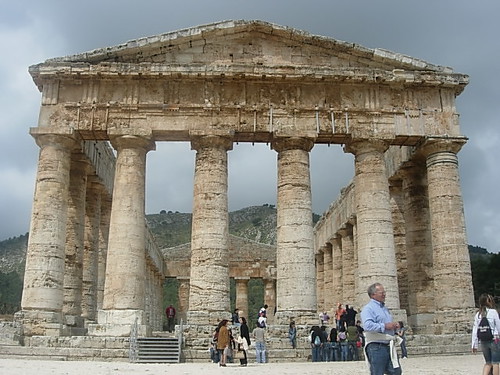
Photography by Chiara Marra
Castellammare del Golfo:
Since we caught them really close to Segesta (half an hour by car), we complement the bathroom with a more prosaic cultural, and headed to the beach of Castellammare del Golfo.Great set, it could be just a needle on the beach and had to compete for a place in the car parks in front (for a fee but cheap, 3 € per day). We became hollow, we ate at one of its many bars, rent a corresponding umbrella and join the swimmers in the art of wet and dry.
Castellammare del Golfo beach is crowded, noisy and popular, and an excellent opportunity to see the Sicilian sauce. We enjoyed the visit of this and other beaches of Sicily.
Selinunte:
Back to cultural immersion. Selinunte was one of the most important Greek polis of the Mediterranean, around the V century BC, as evidenced by its impressive ruins. We are talking about several Doric temples, some better preserved than others, all spectacular.There is the largest Doric temple ever known (well above those of the Acropolis of Athens), yet centuries ago bit the dust due to successive earthquakes, and today there is only one column standing, nicely restored in the nineteenth century to attest to the magnificence of this ancient home of the gods.
You can also visit the Acropolis of Selinus, built by Greek colonists, later destroyed by the Carthaginians hired from rival Segesta, repopulated by the Carthaginians themselves, who would then Romans, Normans, etc. Each town’s fits your taste and needs, building on earlier buildings, but still a good guide can unravel many of its secrets.
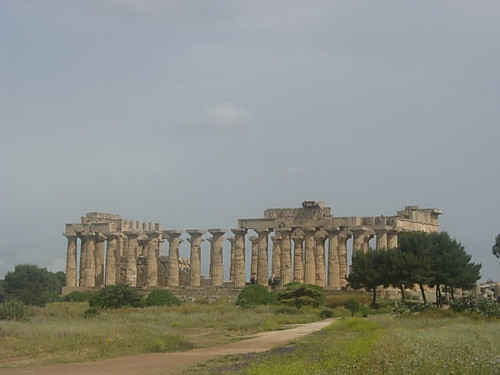
Photography by Chiara Marra
Agrigento:
Agrigento in southern Sicily, looking towards Africa (particularly in Tripoli). This is another important Greek polis (Akragras) in the ancient world, which played a key role in the political map of Sicily for centuries. Today his legacy lives clearly historical, thanks to the famous Valley of the Temples. There you can admire (along with thousands of tourists) the perfect proportions of one of the best preserved Greek temples of antiquity: the Temple of Concord.Contemplate him 2500 years, although not the oldest or alone in this vast archaeological site.The Valley of the Temples is the only place where you can stroll among Doric columns at night, with all its treasures adequately lit. Magic.
Otherwise, Agrigento and the area south of Sicily are quite poor, and surprised to see the very high number of abandoned buildings and half-built anywhere.
Enna:
Enna is a city rich in history and is strategically located atop a hill overlooking Sicily. Populated by Greeks from 664 BC, gained real importance during the Muslim rule and later Middle Ages, as controlled Enna who controlled Sicily.
Today is a beautiful and rather sprawling air Sicilian village, with stone and shadows everywhere. Strolling through the hilly streets is unpleasant, and becomes the less an excellent stop on the way to Agrigento to Siracusa.
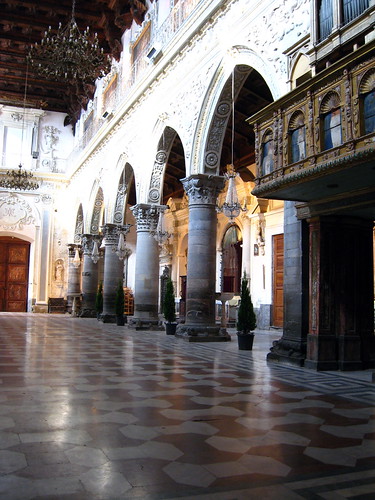
Photography by andrewmalone
Piazza Armerina:
A little further on is another town worth seeing. Piazza Armerina is a lively Sicilian town like few others; I saw more hustle in the streets (no tour) and elsewhere on the island. There were carts of fruit and roadside stands throughout downtown, dotted with lively terraces also, people came and went shopping and had bloating and joy in the streets. The pity is that we direct our next stop, the Roman Villa of Casale, and we could only admire the Piazza Armerina atmosphere in your car.

Photography by gerlos
The Roman Villa of Casale deserved that and more, is the village that showcases the most extensive Roman mosaics and best preserved of the world. And although the coating that protects the village from bad weather is rough and very controversial, since it prevents appreciate the size and shape of the Roman house and ugly over the set, once inside we drool at the scenes perfectly preserved mosaics. Corridors and hallways of scenes, very impressive. Will devote a full entry soon.
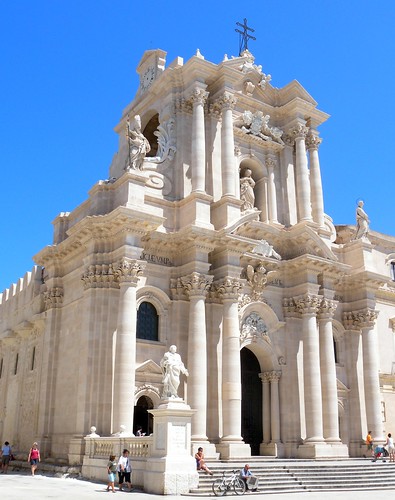
Photography by girolame
Syracuse:
Founded shortly after Rome in 734 a. C., was for centuries more powerful than the eternal city, and even got to overcome for a time in power and glory to the very Athens. The story of Syracuse is full of dramatic events and momentous for the West, and famous names like Archimedes or Dionysius I. Today we find great vestiges of their greatness as the Temple of Apollo, the Fountain of Arethusa, the Latomia of Paradisso or Ear of Dionysius, not to mention the excellently preserved Greek Theatre, of enormous dimensions and completely excavated on a hill overlooking the sea.
Syracuse is magical because it is true, history permeates the streets and facades without yielding to the sets of cardboard that can be found elsewhere hyper restored. The nightlife is extremely lively, bohemian, and a drink in any of its terraces invite to lose track of time. Only Syracuse, would a thousand times to visit Sicily.
Catania:
The place is a veritable feast of fresh food stalls and shops in the most varied in the market of Catania missed for an entire morning while distracted by so many and so varied. They say that the Sicilians are suspicious of supermarkets and seek to always buy fresh produce, and if the street is better. Maybe that’s why the market of Catania has such good health: there you can buy all sorts of vegetables, meats, fish, cheese, any food that comes to mind, just brought (or so they say). Sellers shout joyfully while depicting gender, buyers barely move among the narrow streets, umbrellas create a curious red roof and the huge cathedral presides over the scene in the background. Catania market deserves an entry on many, many photos.
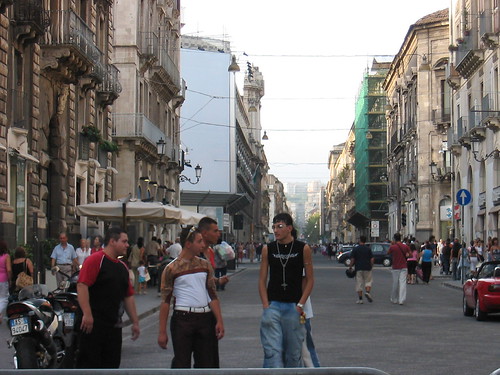
Photography by vic15
Taormina:
Taormina appears on all blogs and guidebooks as a must-see in Sicily. And sure to be included in many more places recommended, since summer is crowded to say enough. It is the most expensive and chic people (also the most artificial) of Sicily, the place to see and be seen. Almost has a single street, town houses and trade sophisticated, very well maintained throughout, though. Experience is the closest thing to tourism on rails. Still, worth an afternoon visit Taormina, and being 200 meters above sea level have a privileged view of the coast.Also recommended by the sharp contrast with the other cities we visited on our way to Sicily.
Cefalù:
Cefalù left us speechless, not surprisingly, is the star of the Tyrrhenian Sea town. See the picture of houses silhouetted against the shore, with the cathedral and the Rock in the background is one of those indelible images that we take Sicily. And, the beach was great, we did a swim of the good and we spent a few hours in an atmosphere of lively and very pleasant beach. And da Cefalù more, because strolling through its cobbled streets is pure enjoyment. The best seaside town of Sicily, among which we saw on our way.
Himera:
Already on our way back to Trapani, we stayed at a hotel outside Termini Himerese today almost insignificant village in the north of Sicily, but has some remains of the illustrious Greek polis Himera. This was also a place of one of the most momentous battles of antiquity, he faced in the 480 to C. Greeks and Carthaginians for control of the Mediterranean. The Greeks won, and celebrated with the construction of a Doric temple whose few remains can be visited today. I I could not resist visiting the temple of victory, and though they hardly retains stylobate and some remains of the columns, the fact of walking through the temple to daylight and alone, with no company but my breathing was great. And is that these ruins are practically abandoned, however, are testimony to one of the most celebrated and fleeting triumphs of ancient history.
Erice:
Another captive of any recommendation of Sicily. Erice is only 13km from Trapani, but feel like 50km to be saved as 930 m. in height between the two, for some pretty bad roads. The village is situated in a pingorote from which you can see all Trapani and much of the west coast of Sicily. I really did not see his special charm to Erice, a stone town dedicated to tourism and ceramics but nothing remarkable, I’ve seen far more beautiful in the Aragonese Pyrenees and Catalan. That itself has a long history in the stones of the streets. There must also say that we went to Erice drive a route very very bad, those that require continuous zig-zag with a slope of 15% for several kilometers. I got tired and pissed off the people, so it was difficult to Erice to impress me.

Photography by elpit
As with all other points of interest on our route through Sicily, you’d better find out if it’s worth a visit!
One Response to “Walking in Sicily”
Leave a Reply
You must be logged in to post a comment.
septiembre 16th, 2011 at 9:17 am
I visit to Sicily last year for some official work and I have not enough time to view it.
Now I am planning to visit again in December.
Your information help me lot to set up my tour.
Thanks for the information.